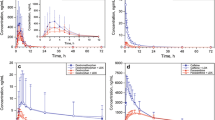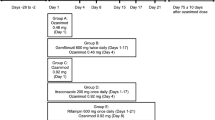Summary
The mechanism of the theophylline-enoxacin interaction has been studied in six healthy subjects. Theophylline 250 mg was administered p.o., twice daily for 11 days in a sustained release dosage form. On the 4th day of treatment, blood samples were taken every 2 h and urine was collected over 1 dose interval. From Days 5 to 11 coated tablets of enoxacin 400 mg b.i.d. were coadministered. On Day 11 blood and urine were collected as on Day 4.
The mean plasma theophylline concentration rose from 4.4 to 15.1 mg/l, corresponding to a 73.6% reduction in total clearance. The urinary excretion of unchanged theophylline increased from 12.7 to 35.3%, whereas the production of metabolites was reduced (1-demethylation 81.4%; 3-demethylation 83.1%, 8-hydroxylation 74.6%).
The results indicate that the theophylline-enoxacin interaction may be due to inhibition of the cytochrome P-450 isozymes responsible for theophylline metabolism.
Unexpectedly, the renal clearance of theophylline metabolites was found to be drastically reduced when enoxacin was coadministered. This led to unchanged or even to elevated plasma levels of the metabolites. The mechanism of this interaction is still to be elucidated, but it may be due to competition for renal tubular secretion.
Similar content being viewed by others
References
Birkett DJ, Grygiel JJ, Miners JO (1982) Metabolic disposition of the methylxanthines in man. In: Rietbrock N, Woodcock BG, Staib AH (eds) Methods in clinical pharmacology, number 3: Theophylline and other methylxanthines. Vieweg & Sohn, Braunschweig Wiesbaden, pp 149–158
Birkett DJ, Miners JO, Attwood J (1983) Secondary metabolism of theophylline biotransformation products in man — route of formation of 1-methyluric acid. Br J Clin Pharmacol 15: 117–119
Fourtillan JB, Granier J, Saint-Salvi B, Salmon J, Surjus A, Tremblay D, Vincent Du Laurier M, Beck S (1986) Pharmacokinetics of ofloxacin and theophylline alone and in combination. Infection 14 [Suppl 1]: S67-S69
Grygiel JJ, Wing LMH, Farkas J, Birkett DJ (1979) Effects of allopurinol on theophylline metabolism and clearance. Clin Pharmacol Ther 26: 660–667
Miners JO, Wing LMH, Lillywhite KJ, Robson RA (1985) Selectivity and dose-dependency of the inhibitory effect of propranolol on theophylline metabolism in man. Br J Clin Pharmacol 20: 219–223
Sachs L (1978) Angewandte Statistik. Springer-Verlag, Berlin Heidelberg New York
Staib AH, Harder S, Mieke S, Beer C, Stille W, Shah PM, Frech K (1986) Gyrase-Hemmer können die Coffein-Elimination verzögern. Dtsch Med Wochenschr 111: 1500
Tang-Liu DD, Willians RL, Riegelman S (1982) Nonlinear theophylline elimination. Clin Pharmacol Ther 31: 358–369
Wijnands WJA, van Herwaarden CLA, Vree TB (1984) Enoxacin raises plasma theophylline concentrations. Lancet 2: 108–109
Wijnands WJA, Vree TB, van Herwaarden CLA (1985) Enoxacin decreases the clearance of theophylline in man. Br J Clin Pharmacol 20: 583–588
Wijnands WJA, Vree TB, van Herwaarden CLA (1986) The influence of quinolone derivatives on theophylline clearance. Br J Clin Pharmacol 22: 677–683
Author information
Authors and Affiliations
Rights and permissions
About this article
Cite this article
Beckmann, J., Elsäßer, W., Gundert-Remy, U. et al. Enoxacin — a potent inhibitor of theophylline metabolism. Eur J Clin Pharmacol 33, 227–230 (1987). https://doi.org/10.1007/BF00637553
Received:
Accepted:
Issue Date:
DOI: https://doi.org/10.1007/BF00637553




